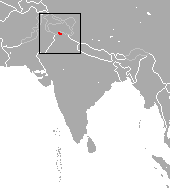Cashmere Hanuman Langur
| Cashmere Hanuman Langur | ||||||||||||
|---|---|---|---|---|---|---|---|---|---|---|---|---|
| Systematics | ||||||||||||
|
||||||||||||
| Scientific name | ||||||||||||
| Semnopithecus ajax | ||||||||||||
| ( Pocock , 1928) |
The Kashmir-Hanuman-Langur ( Semnopithecus ajax ), also called Kashmir-Hulman , is a primate species from the group of slender monkeys and is one of the six species in which the sub-genus Hanuman-Langur belongs to the genus of Indian langurs ( Semnopithecus ), in more recent classifications.
features
Like all Hanuman langurs, they are slender, long-tailed animals. The head-trunk length of adult animals is between 50 and 79 cm, the tail is between 72 and 96 cm long and male monkeys can reach a weight of approx. 20 kg. The shaggy fur is predominantly yellowish-white, the back, the limbs and the tail have a brownish tinge. The tail end is white. The forearms are darker and the hands and feet are the darkest. The hairless face is dark and has bulges above the eyes. The ears are black.
Way of life
These primates only live in a small area in northern India . The small distribution area of less than 5000 km² includes the Chamba district in the north of the Indian state of Himachal Pradesh and possibly extends as far as the Kishtwartal in the adjacent Jammu and Kashmir . Their habitat are pine forests at altitudes of 2200 to 4000 meters. Little is known about their way of life. They are diurnal animals that mainly live on trees. However, like all Hanuman langurs, they often come to the ground. They live in harem groups, in which a male unites with several females. The diet of these animals consists primarily of leaves, but they also eat pine cones, bark and young twigs.
Danger
Kashmir Hanuman langurs are among the most endangered primates. The main threat is the destruction of their habitat through forest clearing. Their area of distribution is greatly reduced and fragmented. The population is estimated at about 250 adult animals and a total population of 500 copies, the IUCN lists these primates as "high risk" ( endangered ).
literature
- Thomas Geissmann : Comparative Primatology. Springer-Verlag, Berlin et al. 2003, ISBN 3-540-43645-6 .
- Don E. Wilson, DeeAnn M. Reeder (Eds.): Mammal Species of the World. A taxonomic and geographic Reference. Johns Hopkins University Press, Baltimore MD 2005, ISBN 0-8018-8221-4 .
supporting documents
- ^ A b D. Zinner, GH Fickenscher & C. Roos: Family Cercopithecidae (Old World monkeys). Page 734 in Russell A. Mittermeier , Anthony B. Rylands & Don E. Wilson : Handbook of the Mammals of the World: Primates: 3rd ISBN 978-8496553897
- ↑ Semnopithecus ajax in the IUCN Red List of Endangered Species . Retrieved April 19, 2009.

